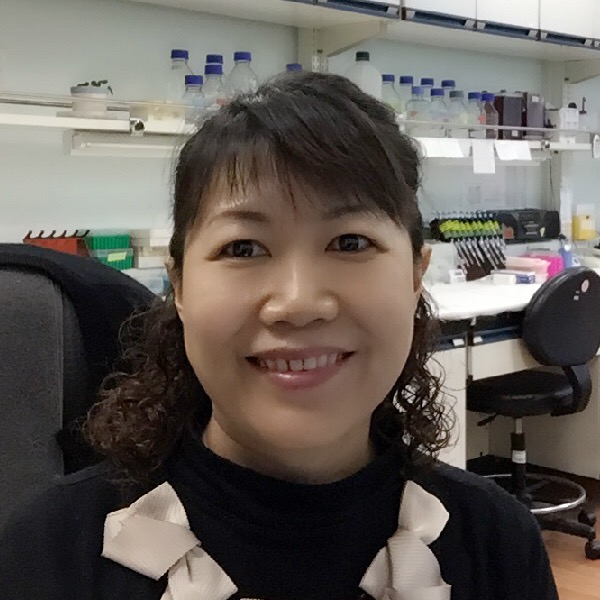 |
Dr. Liu, Hsin-Tzu | |
| E-mail:hsintzu_liu@tzuchi.com.tw | ||
| Ext:12132 | ||
| Tzu Chi University, Taiwan. Ph.D. | ||
| Expertise:Urinary Biomarkers, Pharmacology & Physiology, Molecular Genetics |
Experience:Department of Medical Research. Assistant Researcher
Center for Medical Genetics. Genetic Counsellor
Interest:
|
The main research focus in the laboratory is the investigation of the pathophysiological mechanisms underlying overactive bladder (OAB) syndrome. Our interest in this topic developed through elucidation of the roles of sensory nerve proteins (e.g., nerve growth factor; NGF), sensory nerve receptors (e.g., TRPV1 and P2X3), inflammation-related substances (e.g., prostaglandin E2; PGE2), and oxidative stress-related proteins in the bladders of patients with OAB. We use protein analysis techniques, such as enzyme-linked immunoassay (ELISA) and immunohistochemistry, and molecular biology techniques, such as real-time polymerase chain reaction (real-time PCR), to analyze the regulation and expression of these proteins in the serum, urine and tissues of OAB patients. Using statistical analyses, we compare the protein expressions between OAB patients and control subjects to identify the pathogenesis of OAB. In addition, in order to understand the therapeutic mechanism of onabotulinumtoxinA (BoNT-A) therapy, our laboratory also investigates the changes of bladder functional proteins in the tissue of patients before and after BoNT-A treatment. The results of our current study indicated the following: (1) increased numbers of mast cells in the bladder and elevated levels of serum and urinary NGF and pro-inflammation proteins, which suggested involvement of local or systemic inflammation in certain OAB patients; (2) elevation of P2X3 and PGP9.5 expressions in the bladder mucosa of patients refractory to antimuscarinic drugs, which implied that an abnormally increased level of the sensory receptor P2X3 is one part of the pathogenesis of the disease. In recent years, we found that oxidative stress caused by ischemia and reperfusion also plays an important role in several diseases. Therefore, future goals of our laboratory include the use of rat and transgenic mouse models to study the effects of oxidative stress on the bladder and other organs, and the application of antioxidant drugs in current clinical use for the treatment of other diseases to explore whether the drugs cause molecular pathological changes in the bladders of patients. By comparison with clinical specimens from patients, our study combined basic research and clinical pathologic analysis, and the findings provide an objective reference for clinicians regarding the diagnosis and treatment of diseases. |
Publication (in five years):
|
1. |
Liu HT, Kuo HC: Expressions of urothelial functional proteins in idiopathic detrusor overactivity patients refractory to antimuscarinic therapy with different urodynamic characteristics. Neurourol Urodyn, 2016, Sep 21. doi: 10.1002/nau.23138. [Epub ahead of print].(SCI) |
|
2. |
Chuang FC, Liu HT, Kuo HC: Lower Levels of Urinary Nerve Growth Factor Might Predict Recurrent Urinary Tract Infections in Women. International Neurourology Journal, 2016, 20(1): 33-39.(SCI) |
|
3. |
Liu HT, Chen SH, Chancellor MB, Kuo HC: Presence of Cleaved Synaptosomal-Associated Protein-25 and Decrease of Purinergic Receptors P2X3 in the Bladder Urothelium Influence Efficacy of Botulinum Toxin Treatment for Overactive Bladder Syndrome. PLoS One, 2015, 4;10(8):e0134803. doi: 10.1371/journal.pone.0134803. (SCI) |
| 4. |
Liu HT, Kuo HC: Biomarkers for patients with interstitial cystitis/bladder pain syndrome. Urological Science, 2015, 26(4): 225-229. (Review) |
| 5. |
Liu HT, Jiang YH, Kuo HC: Alteration of Urothelial Inflammation, Apoptosis, and Junction Protein in Patients with Various Bladder Conditions and Storage Bladder Symptoms Suggest Common Pathway Involved in Underlying Pathophysiology. LUTS-Lower Urinary Tract Symptoms, 2015, 7(2): 102-107.(SCI) |
| 6. |
Jiang YH, Liu HT, Kuo HC: Urothelial dysfunction and chronic inflammation in patients with spinal cord injuries at different levels and correlation with urodynamic findings. Neurourol Urodyn, 2015, 34: 757-762.(SCI) |
| 7. |
Jiang YH, Liu HT, Kuo HC: Decrease of Urinary Nerve Growth Factor but Not Brain-Derived Neurotrophic Factor in Patients with Interstitial Cystitis/Bladder Pain Syndrome Treated with Hyaluronic Acid. PLoS One, 2014.9(3): p. e91609(SCI) |
| 8. |
Kuo HC, Liu HT,Chuang YC, Birder LA, Chancellor, MB: Pilot study of liposome-encapsulated onabotulinumtoxina for patients with overactive bladder: a single-center study. Eur Urol, 2014,65(6): 1117-1124(SCI) |
| 9. |
Chuang FC, Liu HT, Wang LY, Kuo HC: Overactive bladder changes with time: a 5-year longitudinal followup of changes in overactive bladder symptoms, urodynamic studies and urinary nerve growth factor levels. J Urol, 2014,192(2): 458-463.(SCI) |
| 10. |
Kuo HC , Liu HT, Shie JH: Potential urine and serum biomarkers for patients with overactive bladder and interstitial cystitis/bladder pain syndrome. Tzu Chi Medical Journal 2013; 25:13-18. |
| 11. |
Liu HT, Jiang YH, Kuo HC: Increased Serum Adipokines Implicate Chronic Inflammation in the Pathogenesis of Overactive Bladder Syndrome Refractory to Antimuscarinic Therapy. PLoS One, 2013;8(10): p. e76706(SCI) |
| 12. |
Jiang YH, Peng CH, Liu HT, Kuo HC: Increased Pro-Inflammatory Cytokines, C-Reactive Protein and Nerve Growth Factor Expressions in Serum of Patients with Interstitial Cystitis/Bladder Pain Syndrome. PLoS One, 2013;8(10): p. e76779(SCI) |
| 13. |
ChenYR, Huang HB, Lo CJ, Wang CC, Ho LK, Liu HT, Shiao MS, Lin DT, Chen YC: Effect of Alanine Replacement of L17 and F19 on the Aggregation and Neurotoxicity of Arctic-Type Ab40. PLoS One, 2013.8(4): p. e61874 (SCI) |